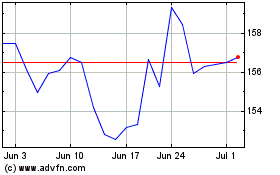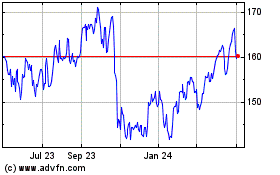Oil Prices Fall on China Data, Output Doubts
February 01 2016 - 12:30AM
Dow Jones News
Crude-oil prices fell in early Asia trade Monday, dragged by l
ackluster Chinese manufacturing data and dimming prospects of a
coordinated production cut by world's dominant oil producers.
On the New York Mercantile Exchange, light, sweet crude futures
for delivery in March traded at $32.93 a barrel at 0349 GMT, down
$0.69 in the Globex electronic session. April Brent crude on
London's ICE Futures exchange fell $0.74 to $35.25 a barrel.
Last week, prices rose on speculation Russia and Saudi Arabia
were considering output cuts to support prices. The gains soon
evaporated after Organization of the Petroleum Exporting Countries
officials refuted such claims.
Hopes of a supply cut sank further after Iran said it "won't
consider a cut" until its exports have increased by 1.5 million
barrels a day over current levels of roughly 1.1 million barrels a
day.
Oil prices have been dogged by oversupply concerns for nearly
two years as major producers continued pumping at high rates to
protect market shares, causing prices to plummet by more than 70%
from 2008 highs.
"In this low-price environment, supply growth is the main issue,
not demand," said Barnabas Gan, a commodity analyst at OCBC.
Prices also fell on disappointing Chinese manufacturing data.
China's statistics bureau reported Monday that the official
manufacturing purchasing managers index fell to 49.4 in January
from 49.7 in December, marking the lowest level since August 2012
and the sixth straight month of contraction.
China's continuing slowdown has weighed on global oil demand.
Last month, China said the country's economy grew 6.9% in 2015, the
slowest pace in 25 years.
"This weak data would likely remind the market of bearishness
again, suggesting more drops for the market in the week ahead,"
said Phillip Futures analyst Daniel Ang.
Still, some analysts say China's crude imports could grow around
7% this year after 2015's 8.8% growth, driven mostly by demand from
local refiners and the government's effort to stock up strategic
reserves.
"PMI is only one of the many factors when gauging China's oil
demand such as electricity use and freight activities," said Vyanne
Lai, an energy analyst at National Australia Bank.
The collapse in oil prices has roiled many oil companies. Some
17 exploration-and-production companies have announced a combined
30% cut in their capital budgets in 2016 from 2015, according to
data compiled by The Wall Street Journal and Tortoise Capital
Advisors.
Last week, Chevron Corp. said it would cut more jobs and capital
spending after reporting a fourth-quarter loss of more than half a
billion dollars.
Analysts say the current investment cuts are setting the stage
for a gradual price rebound, but upsides will be capped by a
stronger U.S. dollar and slowing global growth.
"As a result of the cuts in our forecast for North American oil
production, we have downgraded the 2016 surplus in the global oil
market by 413,000 barrels a day, from 1.045 million barrels a day
previously to 632,000 barrels a day," BMI Research said.
"This steeper-than-expected contraction is signaling that there
will be a price rally in 2016 when the fundamentals take center
stage in price movements," it said.
Timothy Puko, Benoî t Faucon and Summer Said contributed to
this article.
Write to Jenny W. Hsu at jenny.hsu@wsj.com
(END) Dow Jones Newswires
February 01, 2016 00:15 ET (05:15 GMT)
Copyright (c) 2016 Dow Jones & Company, Inc.
Chevron (NYSE:CVX)
Historical Stock Chart
From Mar 2024 to Apr 2024

Chevron (NYSE:CVX)
Historical Stock Chart
From Apr 2023 to Apr 2024
